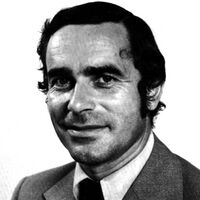André Beyner: Difference between revisions
No edit summary |
No edit summary |
||
| Line 9: | Line 9: | ||
Beyner was selected for the [[Prix Gaïa]] in [[2004]]. | Beyner was selected for the [[Prix Gaïa]] in [[2004]]. | ||
André Beyner married Geneviève Matthey-de-L'Endroit (1902?-November 10, 1967) and the couple had three surviving children: André Beiner-Robert, Marcel Beiner-Keller, and Mrs. Willy Briggen-Beiner. | |||
André Beyner died on April 4, [[1982]] in Le Locle. He was survived by his three children and 8 grandchildren. | |||
[[Category:Biography B|Beyner, André]] | [[Category:Biography B|Beyner, André]] | ||
Latest revision as of 13:52, 26 March 2024

André Beyner-Robert was technical director of Ebauches SA in the 1970s.
André Beyner was the son of André Beiner (1900-1982) and . It is unclear why his brother Marcel and sister spelled the last name "Beiner" while André adopted "Beyner"; his name was sometimes spelled this way as well, though it is universally spelled "Beyner" in watchmaking circles.
Beyner worked on the development of electronic clocks at Ebauches SA in the 1950s, describing clocks with transistors as early as 1958.
In 1978, André Beyner conceived of a watch that integrated the casebook with the main plate of the watch. This was developed by Ernst Thomke to become the revolutionary Delirium, the world's thinnest watch. The same concept would be used in the Swatch, introduced five years later.
Beyner was selected for the Prix Gaïa in 2004.
André Beyner married Geneviève Matthey-de-L'Endroit (1902?-November 10, 1967) and the couple had three surviving children: André Beiner-Robert, Marcel Beiner-Keller, and Mrs. Willy Briggen-Beiner.
André Beyner died on April 4, 1982 in Le Locle. He was survived by his three children and 8 grandchildren.